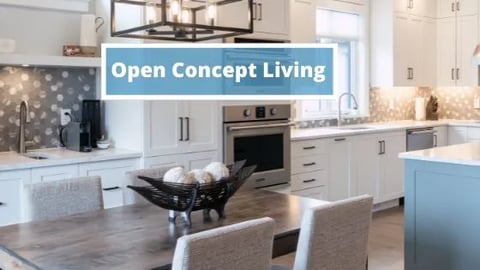How to Design an Open Concept Home: 5 Essential Tips for Style and Function
September 15, 2025

Est. Reading Time: 7 Mins
Once upon a time, homes were divided into distinct, closed-off rooms, and each had its own walls, doors, and clear purpose. Today, the open-concept living layout is one of the most desired in home design, especially in homes in Ottawa, Gatineau, and Kingston, where natural light, flexibility, and a sense of spaciousness are highly valued.
As lifestyle trends evolve, so do our spaces. Open concept floor plans allow your kitchen, dining, and living areas to blend seamlessly, making it easier to cook dinner while chatting with guests or keeping an eye on the kids.
But while the appeal is obvious, designing an open concept home comes with unique challenges.
In this guide, we will explore expert-approved strategies to create a functional, stylish, and cohesive open concept space that works for your life.
Key Takeaways:
- Open concept layouts create a brighter, airier home, ideal for socializing and family living.
- The absence of walls makes furniture placement in open concept living rooms and dining rooms more strategic.
- Using coordinated colours and textures ensures visual flow.
- Defining functional zones prevents the space from feeling cluttered.
- Combining focal points like a TV above a fireplace can optimize wall space.
- Planning your layout before buying furniture avoids costly mistakes.
In This Article...
- Define Each Area’s Function in an Open Concept Floor Plan
- Create Flow and Continuity with Coordinated Colours and Styles
- Balance Multiple Focal Points in an Open Concept Living Room
- Use Furniture Placement to Guide Traffic Flow
- Plan Before You Purchase to Avoid Costly Mistakes
- FAQs About Designing an Open Concept Home
1. Define Each Area's Function in an Open Concept Floor Plan
In an open-concept home, the living room, dining area, and kitchen share a single, large space. Without walls to separate them, it is easy for furniture and activities to blend in a way that feels disorganized. That is why clear functional zoning is essential.
Your furniture arrangement should instantly tell people where each activity happens, for example, “This is where we eat meals, and this is where we watch TV.” Avoid letting living room furniture spill into the dining nook or kitchen walkway.
Michelle MacLellan, Interior Designer at La-Z-Boy Hunt Club, says, "Every area should show a clear design intent to prevent visual clutter and identity loss."

Consider using rugs, lighting, or changes in flooring to subtly separate zones while maintaining the open feel. You can also learn more about How to Decorate in Layers, using this article.
2. Create Flow and Continuity with Coordinated Colours and Styles
Open concept spaces work best when each zone feels unique but connected. Choosing complementary colours, finishes, and furniture styles ensures that your open concept kitchen, dining, and living room look intentional rather than mismatched.
For example, if your kitchen has a farmhouse-style island with rustic wood finishes, your dining table could echo that warmth with distressed wood or neutral upholstery. On the other hand, pairing that same island with a glossy chrome dining set might disrupt the flow.
Trending 2025 Tip: Michelle says warm neutrals, organic textures, and matte finishes are dominating open concept design this year, including oak dining tables, woven dining chairs, and soft beige sectional sofas.
To learn more about What Are the Best Colours for Your Home, take a look at this article.

3. Balance Multiple Focal Points in an Open Concept Space Living Room
One of the trickiest parts of open concept design is dealing with multiple focal points, especially when the living room shares sightlines with the kitchen and dining areas. If your main wall has a fireplace but you also want a TV, combining them into one focal point can save wall space and make furniture placement easier.
Safety Note: Always check your local building codes before mounting a TV over a fireplace, as clearances vary by fireplace type.
When focal points compete, such as a large kitchen island, statement chandelier, and media wall, choose one to be the “star” in each zone and let the others act as supporting features.

4. Use Furniture Placement to Guide Traffic Flow
With no walls to guide movement, traffic flow in an open concept home depends entirely on how you place your furniture. Arrange seating and tables in a way that creates natural walkways between zones.
Avoid placing bulky furniture in pathways, and ensure there is at least 36 inches of clearance between furniture pieces. Sectionals, console tables, and strategically placed chairs can subtly direct movement without feeling restrictive.
To learn more about Practical Tips for Arranging Your Living Room Furniture, take a look at this article.

5. Plan Before You Purchase to Avoid Costly Mistakes
The most common mistake homeowners make in open concept design is buying furniture before planning the layout. Start with a floor plan, measure each area, and visualize where key pieces will go.
This ensures you choose the right sofa size for your open concept living room and avoid awkward gaps or overcrowding. Michelle advises, "Making a plan first eliminates potential problems and helps you envision the final layout."
What also helps is figuring out the proper measurement to ensure your furniture isn’t too large or small for your space. To learn more about How to Measure Furniture Properly, take a look at this article.
FAQs About Designing an Open Concept Home
How do you make an open concept home feel cozy?
Use rugs, layered lighting, and warm colours to create intimacy while keeping the space open.
What is the best furniture for an open concept layout?
Choose flexible pieces like modular sectionals, extendable dining tables, and storage-friendly sideboards that can serve multiple purposes.
How do you separate an open plan living room and dining room without walls?
Try rugs, furniture arrangement, open shelving, or changes in lighting to subtly define each area.
What's Next?
Now that you know how to arrange your furniture properly, it is up to you to decide how you will decorate your space.
While learning about our home decor selections, you can visit one of our La-Z Boy Ottawa, Gatineau & Kingston stores to see our home decor items in person. You can also schedule a visit online before coming in.
Our design consultants are always eager to lend a helping hand. Take advantage of our complimentary interior design services to see how our furniture and decor could fit in your home.
To learn more about our La-Z-Boy decor selection, take a look at this comprehensive Living Room Furniture Buyer’s Guide, as well as our Decor Buyer’s Guide.
Related Articles:
Ideas for Decorating Your Living Room
(1).jpg?width=150&height=150&name=9C8A3062-Enhanced-NR%20(1)(1).jpg)
Nicholas Carchidi
Content Writer at StyleMeetsComfort.ca
Nick has been the lead content writer for La-Z-Boy Ottawa, Gatineau and Kingston since 2022, specializing in the furniture industry. He collaborates with experts in his field, ensuring that each piece on the La-Z-Boy Learning Centre is accurate and valuable. He provides readers with expert knowledge on all things furniture. If you'd like to learn more about Nick, you can check out his LinkedIn page here.
Product Info Request
Please provide us with your name and email and we'll get back to you as soon as possible regarding this item.


